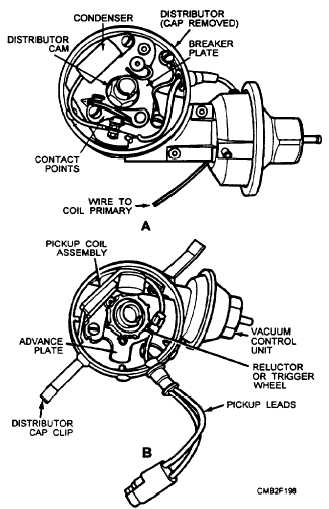When the current flowing through the coil is broken (the primary circuit is opened), the magnetic field collapses across the secondary windings. As the magnetic field collapses, a high electrical voltage is induced into the secondary circuit.
Since both the primary and secondary windings of the coil are stationary, some means other than movement of the windings must be found to change the magnetic field surrounding the coils. In practice, a switching device in the primary circuit creates this effect. There are two common methods to break current flow and fire the coil - mechanical contact points or an electronic switching device.
Ignition Distributor
An ignition distributor can be a contact point or pickup coil type, as shown in figure 2-45. A contact point distributor is commonly found in older vehicles,

Figure 2-45. - Comparison of a (A) contact point distributor and a (B) pickup coil distributor.
whereas the pickup coil type distributor is used on many modern vehicles. The ignition distributor has several functions, which are as follows:
It actuates the ON/OFF cycles of current flow through the primary windings of the coil.
It distributes the high voltage surges of the coil to the spark plugs.
It causes the spark to occur at each spark plug earlier in the compression stroke as speed increases.
It changes spark timing with the changes in engine load. As more load is placed on the engine, the spark timing must occur later in the compression stroke to prevent spark knock.
In some cases, the bottom of the distributor shaft powers the engine oil pump.
In some electronic distributors, the distributors house the ignition coil and the electronic switching unit.
DISTRIBUTOR CAP. - The distributor cap is an insulating plastic component that covers the top of the distributor housing. Its center terminal transfers voltage from the coil wire to the rotor. The distributor cap also has outer terminals that send electric arcs to the spark plugs. Metal terminals are molded into the plastic cap to provide electrical connections.
DISTRIBUTOR ROTOR. - The distributor rotor transfers voltage from the coil wire to the spark plug wires. The rotor is mounted on top of the distributor shaft. It is an electrical switch that feeds voltage to each spark plug wire in turn.
A metal terminal on the rotor touches the distributor cap center terminal. The outer end of the rotor ALMOST touches the outer cap terminals. Voltage is high enough that it can jump the air space between the rotor and cap. Approximately 4,000 volts are required for the spark to jump this rotor-to-cap gap.
SPARK PLUG
The spark plug consists of a porcelain insulator in which there is an insulated electrode supported by a metal shell with a grounded electrode. They have a simple purpose of supplying a fixed gap in the cylinder across which the high voltage surges from the coil must jump after passing through the distributor.
The spark plugs use ignition coil high voltage to ignite the fuel mixture. Somewhere between 4,000 and 10,000 volts are required to make current jump the gap 2-33
Continue Reading